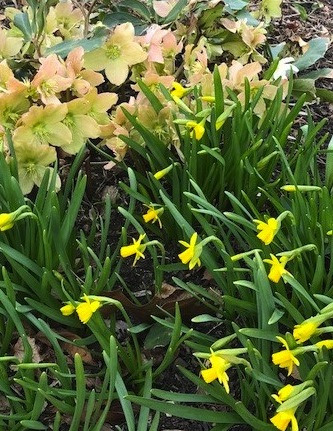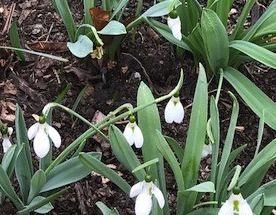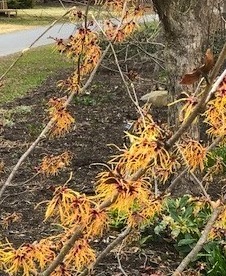Meadowlark: Spring Beckons: Come Volunteer!
By Jennifer Naughton, Fairfax Master Gardener

Hellebores and Daffodils
As my husband drives our family from Virginia to Florida on our annual spring break, I am mesmerized by the scene outside my car window. Despite the cramped quarters of a car overpacked with beach gear and growing kids’ outstretched legs on the center console, the ride is a delight. There is an ever-changing explosion of spring outside. It’s the reason I refuse to fly, although it would allow us a full extra day at the beach. The panorama south down Interstate 95 is a miniature time lapse of this season’s unfolding: grasses green and trees flower then leaf, fill out, shimmer and glow with new vitality. There are bursts of color. Robert Frost writes, “Nature’s first green is gold” but pink is the initial blur of warmth, as the Red Maple
(Acer rubrum) spreads her “early leaf a flower.” Nearer the border of South Carolina, oranges, yellows and bright greens dot the landscape. I see expectant vivid Redbuds
(Cercis) and even a patch of early Wisteria.

Galanthus elwesii
Unlike most vacation goers, I look forward to returning to work after this trip is finished for the in-depth study of spring it affords. My job as a part-time seasonal gardener at Meadowlark Botanical Garden is more privilege than chore. It allows me intimacy with the earth, a close listening to the heartbeat of each season. These early weeks in March at Meadowlark brought a preview of what’s to come: Hellebores
(Helleborus) and Daffodils
(Narcissus) bright during grey, cold days; Witch Hazel’s
(Hamamelis ‘Diane’) golden red blooms hanging in sassy, defiant decoration as temperatures drop in the 30’s; Snow Drop Crocus
(Galanthus elwesii) littering the sides of pathways like garden jewels, and Pussy Willow’s
(Salix caprea)M fuzzy warm buds edged in ice.

Hamamelis ‘Diane’
Meadowlark’s garden is birthing new treasures each day, and the staff is working hard to keep up and ready the park for the real show to come. My supervisor, horticulturalist Carol Miranda, along with fellow horticulturalist Keely Shaughnessy, lead horticulturist Tammy Burke and their staff are busy inside. Landscape plans are drawn, plants ordered, seeds such as Marigold
(Tagetes patula) ‘Strawberry Blonde’, Vinca
(Catharanthus roseus) ‘Cora White’), Ornamental Pepper
(Capsicum) ‘Midnight Fire’, and Dahlia
(Dahlia variabilis) ‘Sunny Reggae’ started, Canna and Elephant Ear
(Colocasia) are thinned and divided, cuttings from multicolored, ruffled Coleus
(Plectranthus scutellariodes) propagated and tended. The greenhouse and hoop house are bursting with life, Madagascar Jasmine
(Stephanotis) literally climbing the ceiling ready to escape and take root. The staff is busy outside, too — braving the early spring cold, cleaning up debris, mulching and picking up thousands of sticks strewn about by winter winds.

Seed starting in the greenhouse
All this preparation is actually a quiet beginning to the surge of work ahead. The 95-acre park is made new each spring with endless hours of maintenance and planting. As a partially publicly funded Northern Virginia Regional Park, the staff of 11 full-time and 15 part-time employees under park manager Keith Tomlinson must rely on its stalwart volunteers who believe in its mission to make this magic happen. According to Botanic Gardens Conservation International (BGCI), Botanic gardens are institutions holding documented collections of living plants for the purposes of scientific research, conservation, display and education. In current times, they are becoming key players in both the conservation of plants and education of the people who come to see them mitigating the effects of climate change, … vital to the survival of the planet. At Meadowlark, this includes conservation collections such as the Potomac Valley Collection (PVC), the Virginia Native Tree Collection (VNW) and the Virginia Native Wetland Collection (VNW).
With such an important job, it’s no wonder long-time volunteers like Alice or Royce; the Vienna Five Hills Garden Club; Jean, a federal government retiree and backyard chicken keeper; or Ken, a retired teacher, devote their time, energy and talent. These loyal volunteers are impressive, the dedication year after year to the park heartwarming. The bond between volunteers and Meadowlark expands into a personal affair with staff, and true friendships are born. Meadowlark is built on the generous nature of those who believe in the public mission of botanical gardens and are willing to bring this to life for the benefit of our community through their hard work. It is a team effort between staff and volunteer and the sense of camaraderie this work brings creates a botanical garden full of rare beauty, a respite in the midst of overdeveloped Northern Virginia.
Poet Philip Larkin captures springtime in his poem, “The Trees”:
The trees are coming into leaf
Like something almost being said:
The recent buds relax and spread,
In fullgrown thickness every May.
Last year is dead, they seem to say,
Begin afresh, afresh, afresh.
Spring is a time to renew our commitments and reestablish a relationship with the earth. As Master Gardeners, we do this in our own backyard and the ways we volunteer for our community. This year, consider Meadowlark as an important local partner deserving of your horticultural time and attention. The park needs your strong work ethic, your knowledgeable, deft gardening hands. You will mulch, plant, weed, cut back and care for plants outdoors and in greenhouses. Mostly, you will leave with more than you will give — new gardening knowledge and friendships among people with a common purpose. In the true spirit of springtime, new beautiful worlds will unfold.



